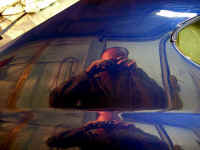This page is a slight detour but an interesting one. I had the chance to paint a friends 1968 Chevelle. He got a paint job and I got to practice (this was my third overall paint job). For better or worse, I also get to practice fixing errors. All of these problems are a normal part of painting, pros just get them less often and are faster and more proficient at fixing them.
Inexperienced people painting in a garage, will ALMOST ALWAYS have three general problems occur:
1) Dust in the paint. Pros have spray booths that minimize this greatly. I washed the garage first and used positive pressure air through filters and wet the floor but there was still dust in the clear. (unavoidable)
2) Bugs in the paint. As above, pros have spray booths to solve this problem. Starting to paint early in the day will minimize this. Most come in at night because of the lights.
3) Runs and dry spots in the paint. Pros are better than me but also have better lighting. On parts of the car that were poorly lighted, I had either runs (too much paint) or some orange peel (not enough paint).
Fortunately none of the problems in this case are too difficult to fix if you color sanding the paint. The details are below (in progress as of 11/11/02)
A word of warning - MAKE SURE you do not cut through the clear. If you do, fixing it can get to be a big deal. You will have to sand the whole panel, blend in the color, then re-clear the whole panel. I tried it only once so far by fixing some chips under the hood, in an inconspicuous place. It looks fine under there but if it had been in the middle of a door I would have a problem. One thing is sure - I will eventually have a chip/scratch/dent to fix for real.
